
Table of Contents (Start)
- Topics
- Introducing SevOne
- Login
- Startup Wizard
- Dashboard
- Global Search - Advanced Search
- Report Manager
- Report Attachment Wizard
- Report Properties
- Report Interactions
- Instant Graphs
- TopN Reports
- Alerts
- Alert Archives
- Alert Summary
- Instant Status
- Status Map Manager
- Edit Maps
- View Maps
- FlowFalcon Reports
- NBAR Reports
- Logged Traps
- Unknown Traps
- Trap Event Editor
- Trap Destinations
- Trap Destination Associations
- Policy Browser
- Create and Edit Policies
- Threshold Browser
- Create and Edit Thresholds
- Probe Manager
- Discovery Manager
- Device Manager
- New Device
- Edit Device
- Object Manager
- High Frequency Poller
- Device Summary
- Device Mover
- Device Groups
- Object Groups
- Object Summary
- Object Rules
- VMware Browser
- Calculation Plugin
- Cisco ACI Plugin
- Database Manager
- Deferred Data Plugin
- DNS Plugin
- HTTP Plugin
- ICMP Plugin
- IP SLA Plugin
- JMX Plugin
- NAM
- NBAR Plugin
- Portshaker Plugin
- Process Plugin
- Proxy Ping Plugin
- SNMP Plugin
- VMware Plugin
- Web Status Plugin
- WMI Plugin
- xStats Plugin
- Indicator Type Maps
- Device Types
- Object Types
- Object Subtype Manager
- Calculation Editor
- xStats Source Manager
- User Role Manager
- User Manager
- Session Manager
- Authentication Settings
- Preferences
- Cluster Manager
- Maintenance Windows
- Processes and Logs
- Metadata Schema
- Baseline Manager
- FlowFalcon View Editor
- Map Flow Objects
- FlowFalcon Views
- Flow Rules
- Flow Interface Manager
- MPLS Flow Mapping
- Network Segment Manager
- Flow Protocols and Services
- xStats Log Viewer
- SNMP Walk
- SNMP OID Browser
- MIB Manager
- Work Hours
- Administrative Messages
- Enable Flow Technologies
- Enable JMX
- Enable NBAR
- Enable SNMP
- Enable Web Status
- Enable WMI
- IP SLA
- SNMP
- SevOne Data Bus
- Quality of Service
- Perl Regular Expressions
- Trap Revisions
- Integrate SevOne NMS With Other Applications
- Email Tips and Tricks
- SevOne NMS PHP Statistics
- SevOne NMS Usage Statistics
- Glossary and Concepts
- Map Flow Devices
- Trap v3 Receiver
- Guides
- SevOne Implementation Guide
- SevOne Best Practices Guide - Cluster, Peer, and HSA
- SevOne Installation Guide - Virtual Appliance
- SevOne NMS Installation Guide
- SevOne SAML Single Sign-On Setup Guide
- Access Control Quick Start Guide - SevOne NMS 5.7
- Data Miner Quick Start Guide - SevOne NMS 5.7
- Flow Quick Start Guide - SevOne NMS 5.7
- Group Aggregated Indicators Quick Start Guide - SevOne NMS 5.7
- IP SLA Quick Start Guide - SevOne NMS 5.7
- JMX Quick Start Guide - SevOne NMS 5.7
- LDAP Quick Start Guide - SevOne NMS 5.7
- Metadata Quick Start Guide - SevOne NMS 5.7
- RESTful API Quick Start Guide - SevOne NMS 5.7
- Self-monitoring Quick Start Guide - SevOne NMS 5.7
- SevOne NMS Admin Notifications Quick Start Guide - SevOne NMS 5.7
- SNMP Quick Start Guide - SevOne NMS 5.7
- Synthetic Indicator Types Quick Start Guide - SevOne NMS 5.7
- Topology Quick Start Guide - SevOne NMS 5.7
- VMware Quick Start Guide - SevOne NMS 5.7
- Web Status Quick Start Guide - SevOne NMS 5.7
- WMI Quick Start Guide - SevOne NMS 5.7
- xStats Quick Start Guide - SevOne NMS 5.7
SevOne Installation Guide - Virtual Appliance
SevOne Documentation
All SevOne user documentation is available online from the SevOne Support customer portal.
Copyright © 2005-2020 SevOne, Inc. All rights reserved worldwide.
All right, title, and interest in and to the software and documentation are and shall remain the exclusive property of SevOne and its respective licensors. No part of this document may be reproduced by any means nor modified, decompiled, disassembled, published or distributed, in whole or in part, or translated to any electronic medium or other means without the written consent of SevOne.
In no event shall SevOne, its suppliers, nor its licensors be liable for any damages, whether arising in tort, contract, or any other legal theory even if SevOne has been advised of the possibility of such damages, and SevOne disclaims all warranties, conditions, or other terms, express or implied, statutory or otherwise, on software and documentation furnished hereunder including without limitation the warranties of design, merchantability, or fitness for a particular purpose, and noninfringement.
All SevOne marks identified or used on the SevOne website, as updated by SevOne from time to time, may be, or are, registered with the U.S. Patent and Trademark Office and may be registered or pending registration in other countries. All other trademarks or registered trademarks contained and/or mentioned herein are used for identification purposes only and may be trademarks or registered trademarks of their respective companies.
Introduction
This document describes the installation of a SevOne virtual appliance. A virtual appliance can be a SevOne Performance Appliance Solution (vPAS) or a SevOne Dedicated NetFlow Collector (vDNC), each of which runs the SevOne Network Management Solution (NMS) software. It can also be a SevOne Performance Log Appliance (vPLA), which runs the SevOne PLA software.
Create Support Account
SevOne support is only a phone call away - +1-302-319-5400. Perform the following steps to create a user account to enable SevOne Support Engineers to provide support services.
-
In the address field on your web browser enter www.sevone.com/support and press Enter.
-
Click Login to display the SevOne Support Login page.
-
In the Create New Account section, enter the following information.
-
Your Full Name
-
Email Address
-
Phone Number
-
Company
-
-
Click Create Account.
-
Your account is created instantly and SevOne Support reviews the account validity within the next business day.
Multi Peer and Hot Standby Implementations
The SevOne NMS Cluster Manager provides an Integration tab to enable you to build your cluster and to add a new PAS appliance and/or a new vPAS as a peer into an existing cluster. The Cluster Manager also provides a Log Data Mapping tab to enable you to map the log data that SevOne PLA collects for volumes to the device groups/device types in SevOne NMS. The SevOne PLA Cluster Manager Settings page enables you to build a SevOne PLA cluster.
When your new virtual appliance is a Hot Standby Appliance, perform the steps in chapters 3 and 4 to install the SevOne software and to integrate the computer into your network then contact SevOne Support to ensure that the Hot Standby Appliance is appropriately implemented into the cluster. Email: support@sevone.com - Phone: +1 302-319-5400
Prerequisites
There are three methods to download the image for a virtual SevOne appliance.
-
VMware - Standard method for all virtual SevOne software installations via a .ova file download from http://fileshare.sevone.com/ftp/login/.
-
KVM (Kernel-based Virtual Machine) - A virtualization infrastructure for the Linux kernel that turns it into a hypervisor. This method uses a .QCOW2 file.
-
Microsoft Azure - The method used to install is a Virtual Hard Disk (VHD) image.
All three methods have the following hardware requirements.
Hardware Requirements
|
Hardware |
vPAS 5k |
vPAS 5k with
|
vPAS 20k |
vPAS 60k |
vPAS 100K |
vDNC 100 |
vDNC 300 |
vDNC 1000 |
vPLA |
|
CPU Count |
2 |
2 |
2 |
2 |
2 |
2 |
4 |
6 |
2 |
|
Total Cores |
2 |
2 |
8 |
8 |
8 |
8 |
16 |
24 |
2 |
|
RAM (GB) |
4 |
8 |
16 (for SevOne NMS release <= 5.7.2.14) 24 (for SevOne NMS release >= 5.7.2.15) |
44 |
64
Higher demands (for example, |
16 |
32 |
64 |
1 GB Memory for every GB |
|
Hard Drives |
150GB |
150GB |
600GB |
150GB/1.3TB |
500GB/2TB |
50GB/400GB |
80GB/800GB |
80GB/1500GB |
Minimum free hard drive space 100 GB storage for every GB of daily uncompressed log data. |
|
Other |
|
|
|
|
|
|
|
|
64-bit Infrastructure |
Used hard drive space vs Provisioned Capacity. Virtual machines are thin provisioned and consumption used space is based on polling the maximum number of licensed objects for 1 year at 5 minute intervals.
Download Virtual Appliance Image File
Perform the following steps to download the virtual appliance image file from the SevOne download server. For VMware this is a .ova file. For KVM this is a .QCOW2 file. For Microsoft Azure, this is a .vhd file.
-
In the Address field on your web browser, enter the virtual appliance image link from the email sent by SevOne.
-
Press Enter and wait for the following dialog to appear.
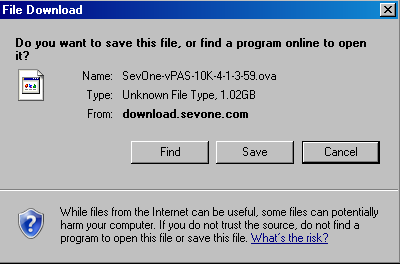
-
Click Save to display the Save As dialog.

-
Navigate to the location in a local folder on your computer where you want to save the image.
-
Click Open to begin the download.
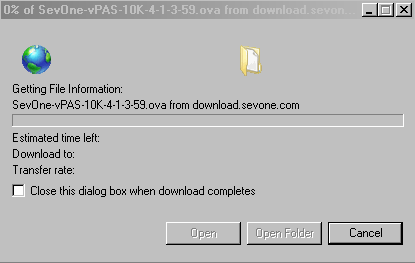
-
Wait till the download is complete (can take up to 20 minutes),
VMware Considerations
A vPAS/vDNC installation using VMware has the following host system requirements
-
Intel-VT or AMD-V CPU extensions
-
VMware ESXi v5.0+
-
Does not run on VMware Workstation / VMware Player
The following are the VMware initial setup best practices.
-
The SevOne .ova image file contains a vmware-tools package to provide emulation for what vCenter and the ESX need to get from the VM. This package provides a set of utilities and drivers to help you improve the performance and management of virtual machines.
-
VMware Tools include the VMXNET3 network driver. The VMXNET3 adapter is a virtualized Network Interface Card that offers better performance and should be used for the vPAS 100K.
-
Turn on Storage I/O Monitoring in vCenter for all data stores used by the appliance to diagnose performance issues.
-
Ensure that hyperthreading is enabled by default in the virtual data center. Hyperthreading is enabled or disabled in the BIOS when the system is booted.
-
Ensure adequate CPU and memory allocation as described earlier in this document. Do not inadvertently limit CPU or memory and ensure that the Unlimited check box is selected.
For a physical system, the concept of a CPU is easy term to understand. However, in the virtualized space it is difficult to determine how many cores a CPU has and whether hyperthreading is turned on. One way to normalize the values you should use to plan your virtual environment is to use the SPECint benchmark published by SPEC. SPEC breaks out CPU performance metrics for:
-
CPU Speed (cint)
-
CPU Throughput (rint)
The cint performance runs a single instance of the benchmark test to measure the speed of the system to perform a single task. rint runs the same number of instances of the benchmark test as there are threads in the machine to measure parallelization. Although a system may have a faster processor, other factors can reduce the number of parallel tasks, so rint is as important a measurement as cint. SevOne software provides good parallelization that benefits from more effective CPUs rather than from a smaller number of faster CPUs.
Example: A machine with two CPUs and four cores per CPU, with one thread per core, may have a speed rating of 10 and a throughput rating of 40, rather than 80, which would be the expected value if all cores and threads were completely independent so this machine has 4 effective CPUs. To expand further, consider a PAS10K which runs on Dell R620 hardware. There are 2 physical CPUs with 8 cores and hyperthreading is enabled. This should result in 32 effective CPUs, but the cint and rint values of 54.7 and 585 determine an effective CPU rating of almost 11, not 32. Similar results exist for the PAS200K (R720xd) which should have 40 effective CPUs but actually rates about 14.
Virtualization can provide better efficiency of the underlying hardware through a fundamental model of over subscription. When set up properly, VMs can freely move about within the cluster of hypervisors to resolve temporary resource constraints without administrator intervention. It is important to note the following:
-
Since the system may attempt to resolve resource contention issues autonomously, performance related postmortem analysis can be difficult via the VM alone.
-
From the VM, it is difficult to determine if you actually have the resources you think you have without an attempt to continuously allocate them, which degrades performance.
-
Some things that constrain the performance of VMs are not things that trigger a VM to move within the cluster.
-
Data points that describe the level of resource contention and over subscription are intentionally not revealed to the VMs and access to vCenter in those scenarios is not universal.
Troubleshooting System Performance
-
Ensure that CPU utilization is in the range of 50-70%. For VMs above this range, vCPUs must be added to the SevOne VM. Note that adding more vCPUs than necessary may adversely affect performance.
-
Ensure adequate reserve of CPU and memory for the VM. Through testing and experience, analyzing esxtop data, the appropriate level of reservation can be determined. Reservations only take effect when there are insufficient resources to meet the needs of all the VMs on a particular ESX server.
VMware Implementation
-
Open your VMware vSphere Client. Your pages may vary from the following screen shots.
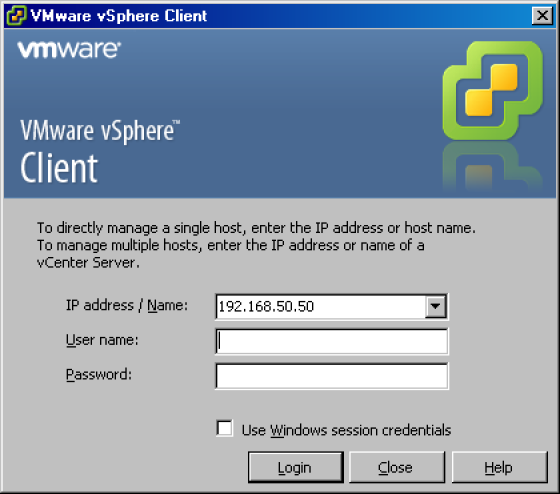
-
Login to your VMware vSphere Client to display the vSphere Client.
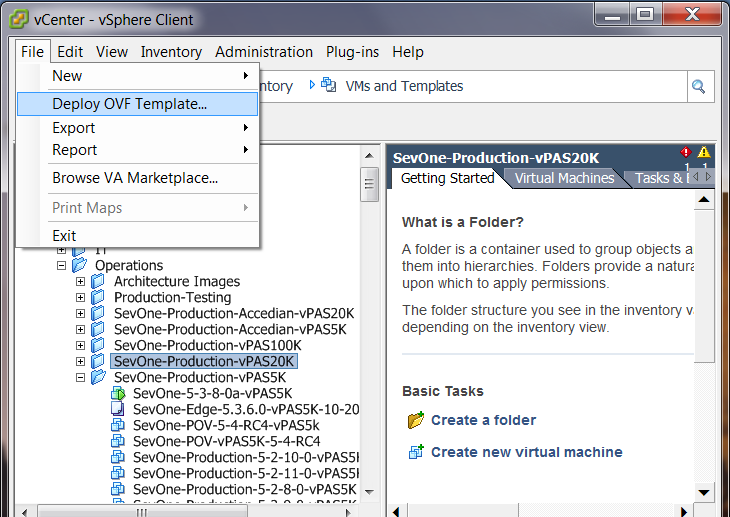
-
Click the File menu and select Deploy OVF Template to display the Source page on the Deploy OVF Template wizard.

-
Click Browse and navigate to the SevOne virtual appliance .ova file you downloaded.
-
Click Next to display the OVF Template Details wizard page.
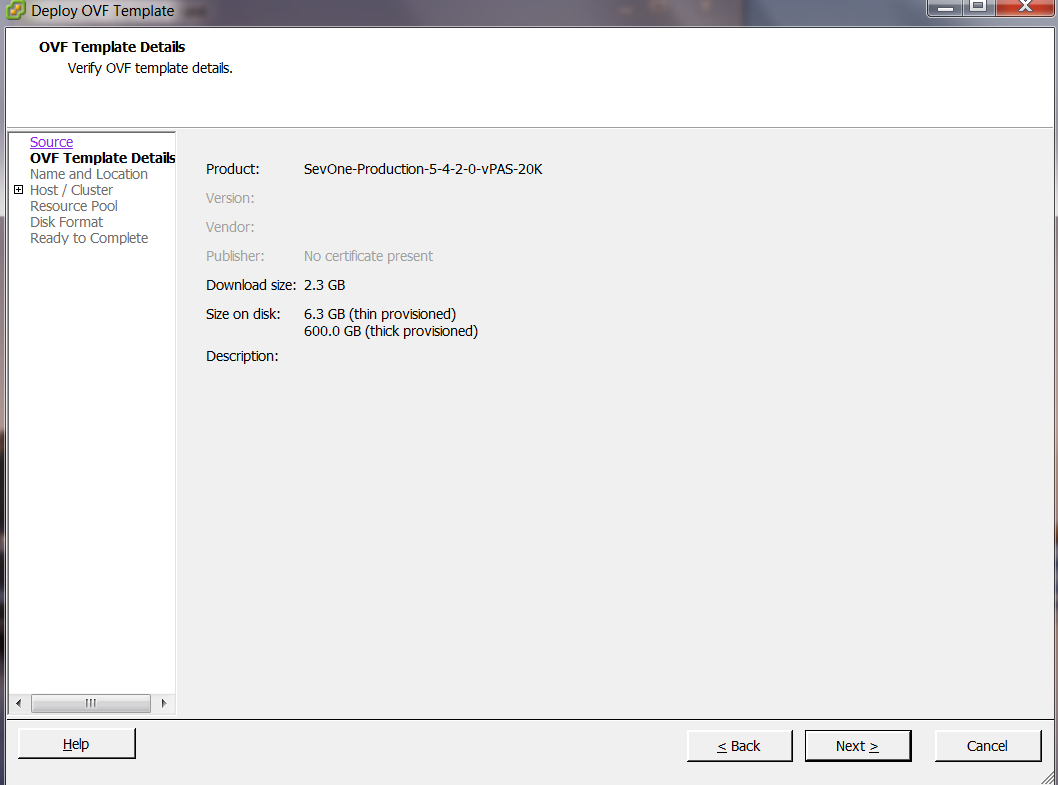
-
Click Next to display the Name and Location wizard page.
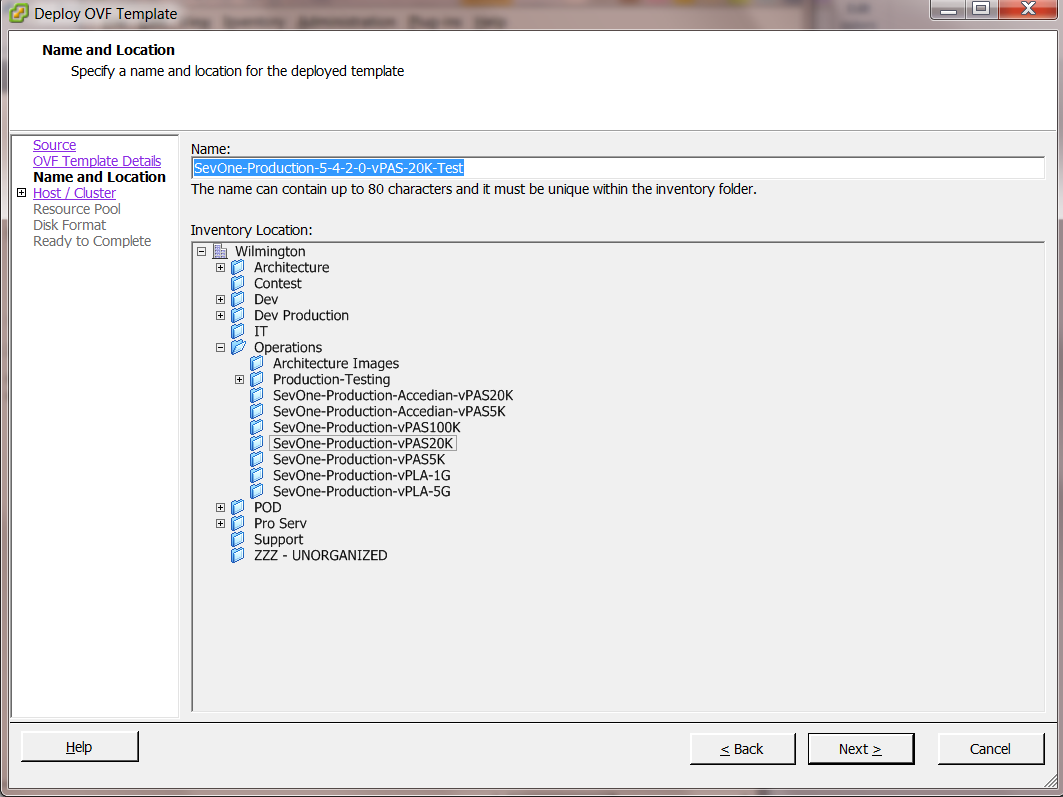
-
In the Name field, enter the name for the vPAS, vDNC, or vPLA.
-
In the Inventory Location field, navigate to the location for the vPAS, vDNC, or vPLA.
-
Click Next to display the Host/Cluster wizard page.
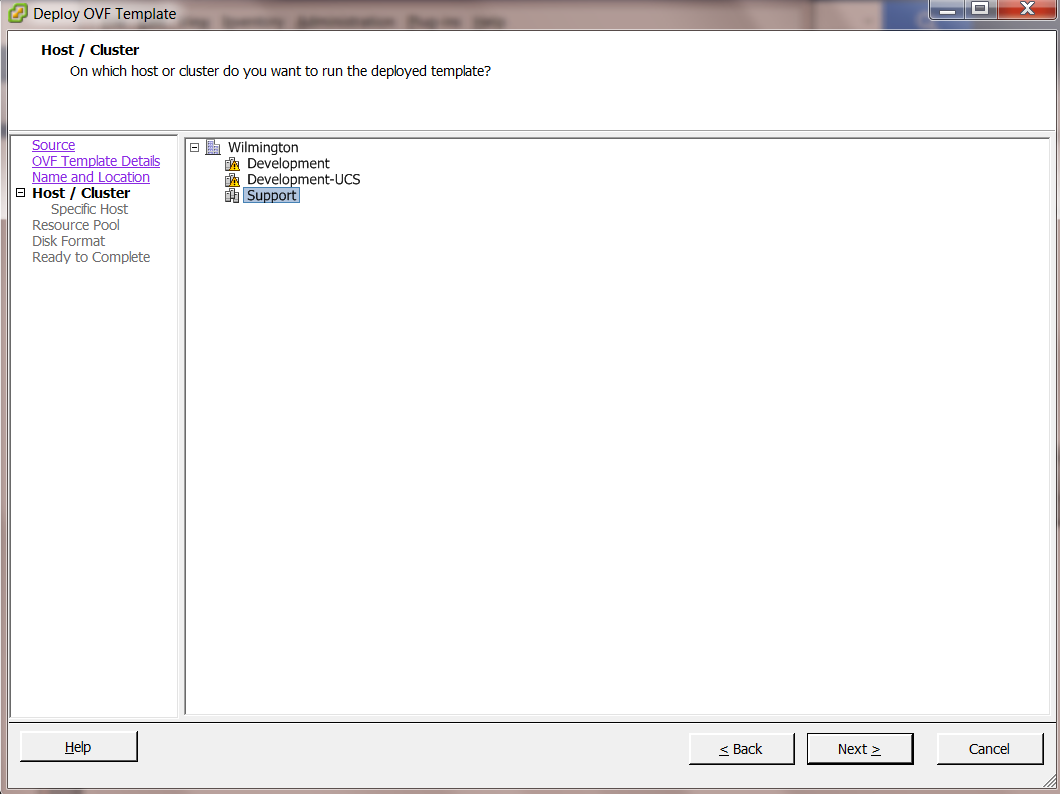
-
Select the cluster to host the vPAS, vDNC, or vPLA.
-
Click Next to display the Storage wizard page.

-
Select the destination for the vPAS, vDNC, or vPLA, (see the Prerequisites and Hardware Requirements chapter for required free space).
-
Click Next to display the Disk Format wizard page.
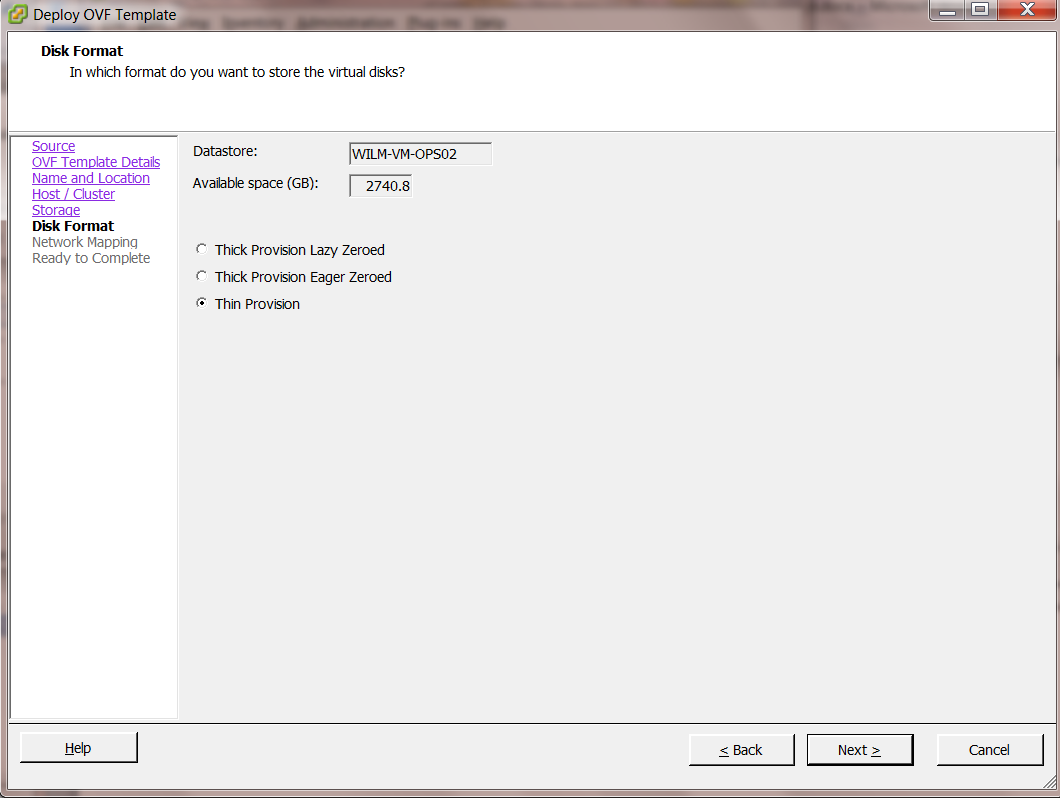
-
Leave the default settings and click Next to display the Network Mapping wizard page.
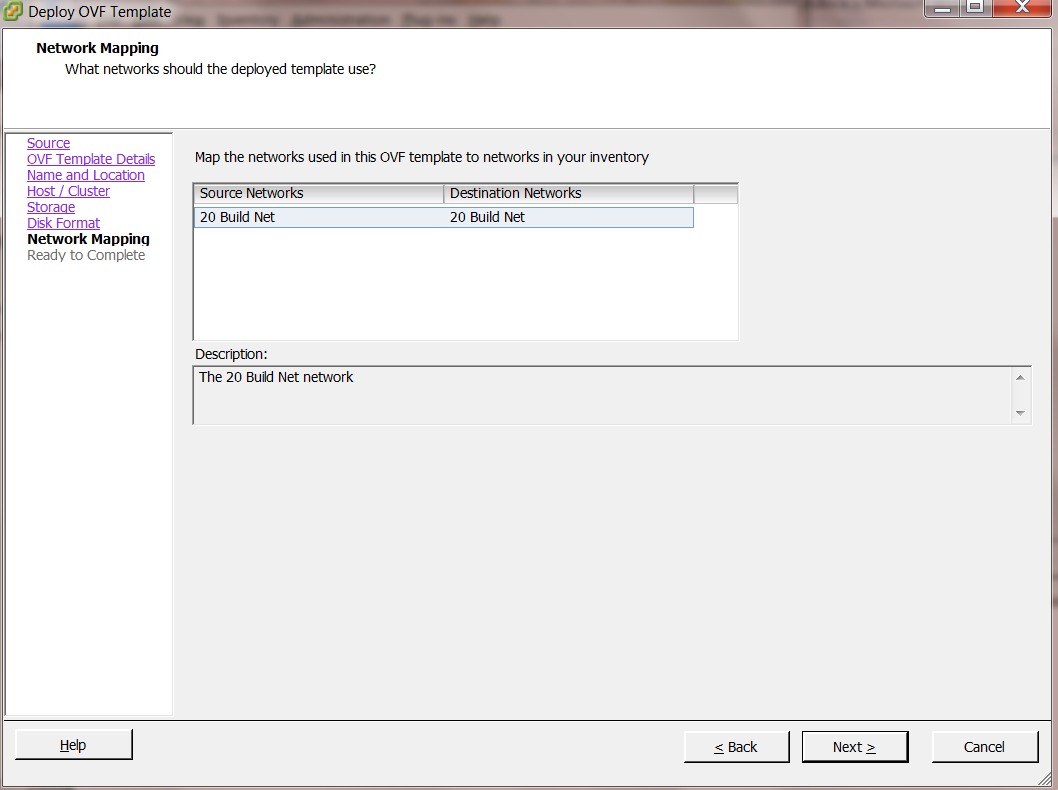
-
Click the Destination Network drop-down and select the destination network.
-
Click Next to display the Ready to Complete wizard page.
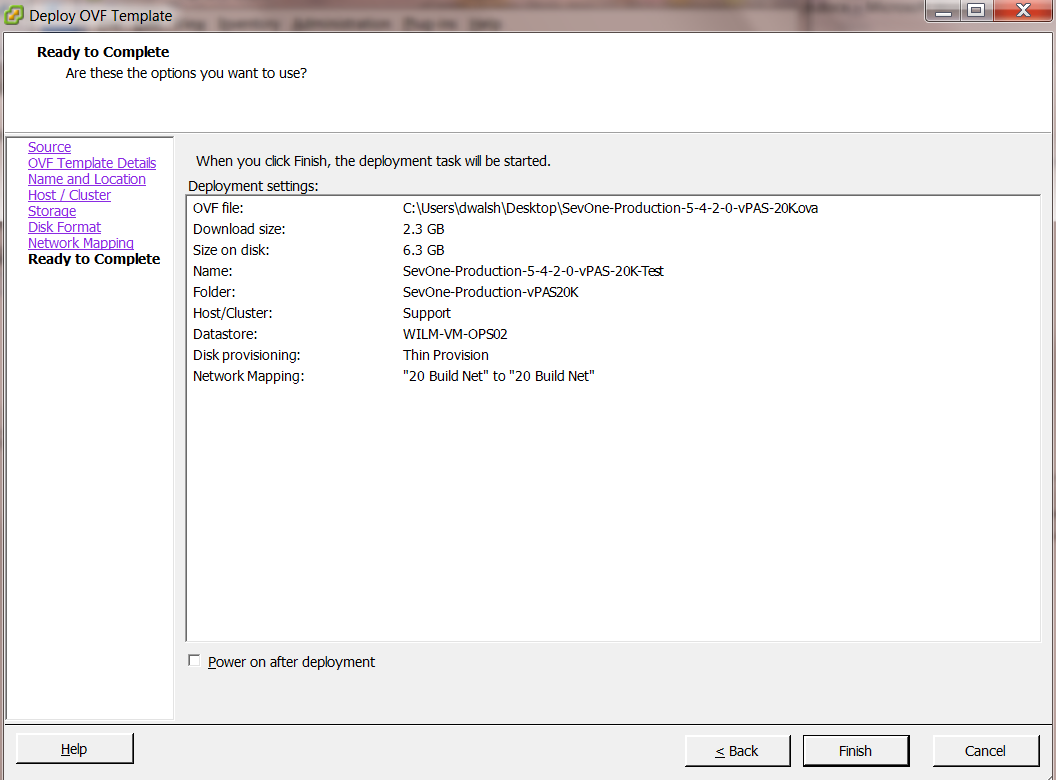
-
Select the Power on After Deployment check box.
-
Click Finish to display the Deploying status message.
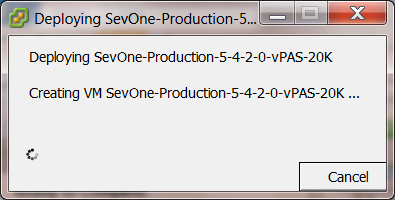
-
Wait until the deployment is complete.
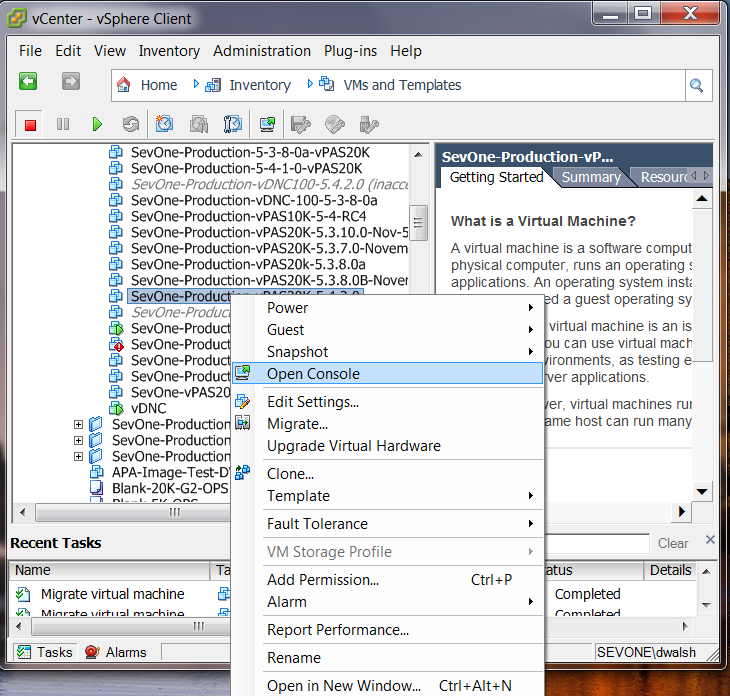
-
Right-click on the vPAS, vDNC, or vPLA and select Open Console to open the console.

-
Wait until the SevOne logo appears.

-
Power on the virtual machine.

-
Proceed to the Network Configuration Via the Config Shell for Both VMware and KVM Implementations chapter.
KVM Implementation
Each KVM implementation varies dependent upon your environment. The following workflow reflects an Openstack implementation. The typical implementation is to set up a private, internal network for the Openstack instances to use for communication. This private network is made available to the public network via NAT. You apply a floating IP address from the public network to the instance's main interface in the private network. Users connect to the floating IP address via their regular network. SevOne instances (each virtual appliance you peer into the cluster) is peered to one another via the private IP address. The private IP address must be reachable (i.e., in the same Neutron network, or otherwise routable). Otherwise, you should use floating IP addresses from the public network to establish peering. Metadata service is not supported.
The KVM image file has a QCOW2 file extension. QCOW2 is a file format for disk image files used by QEMU, a hosted virtual machine monitor. It stands for QEMU Copy On Write and uses a disk storage optimization strategy that delays allocation of storage until it is actually needed. You followed the steps earlier in this document to download the QCOW2 image.
Openstack Installation
Perform the following steps to incorporate the SevOne image via Openstack.
$ glance image-create --name "SevOne Image" --is-public true --disk-format qcow2 \ --container-format bare \ --file SevOne.qcow2Log on to Openstack. If you do not have the Openstack GUI or you prefer to use command line Openstack, see the end of this section for command line instructions.
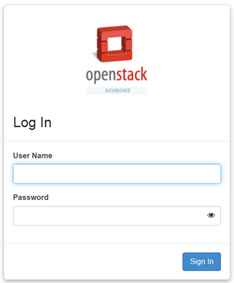
-
In the Username field, enter your Openstack user name.
-
In the Password field, enter your Openstack password.
-
Click Sign In.
The Overview page appears with the System - Overview tab displayed.
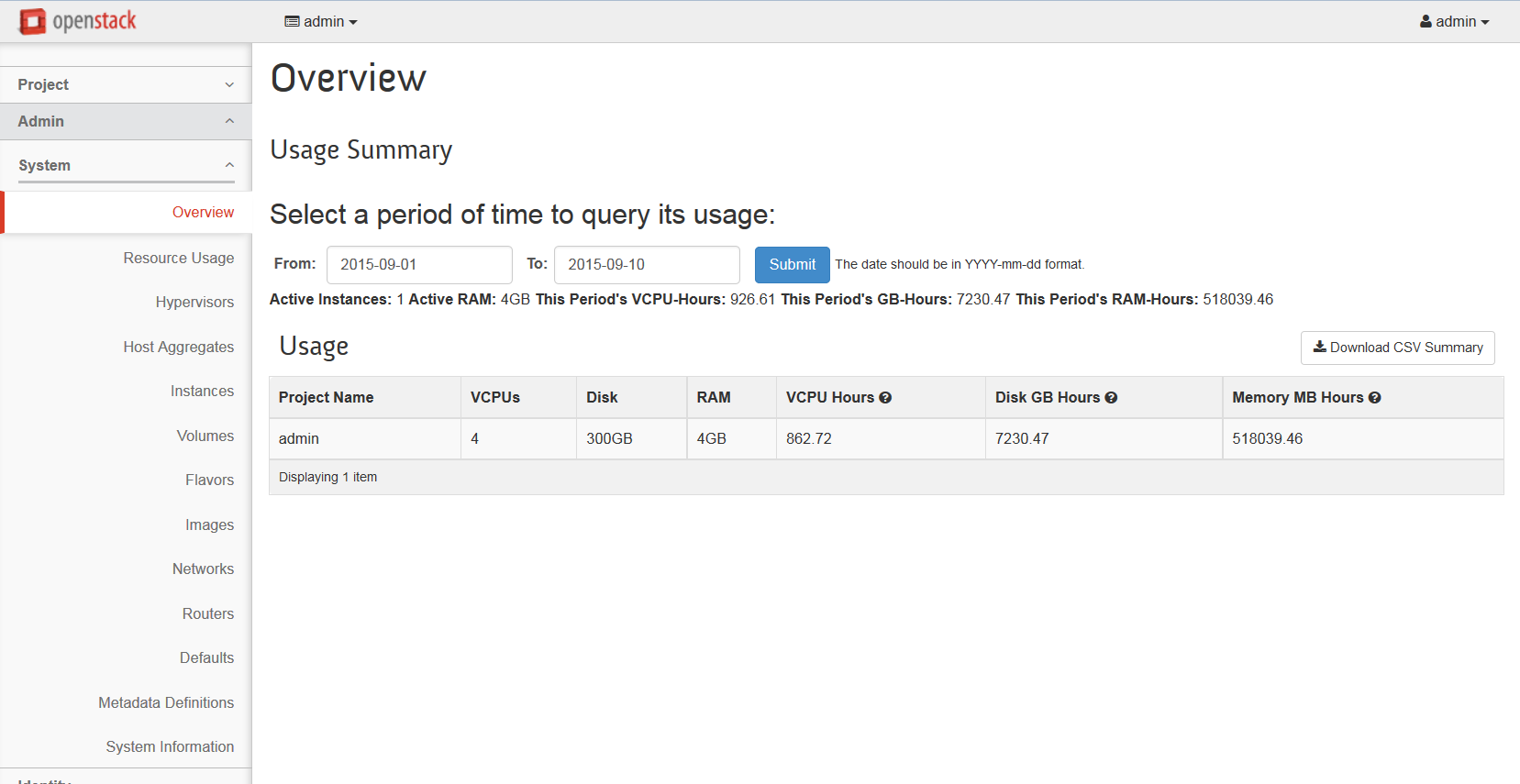
In the left menu, click Project, then select Compute, and then select Overview to display the statistics that enables you to determine if you have enough space for the virtual appliance. See the Hardware Requirements section.

After you confirm that there are enough resources to install the virtual appliance, perform the following steps to create a flavor.
-
In the left menu select System then select Flavors.
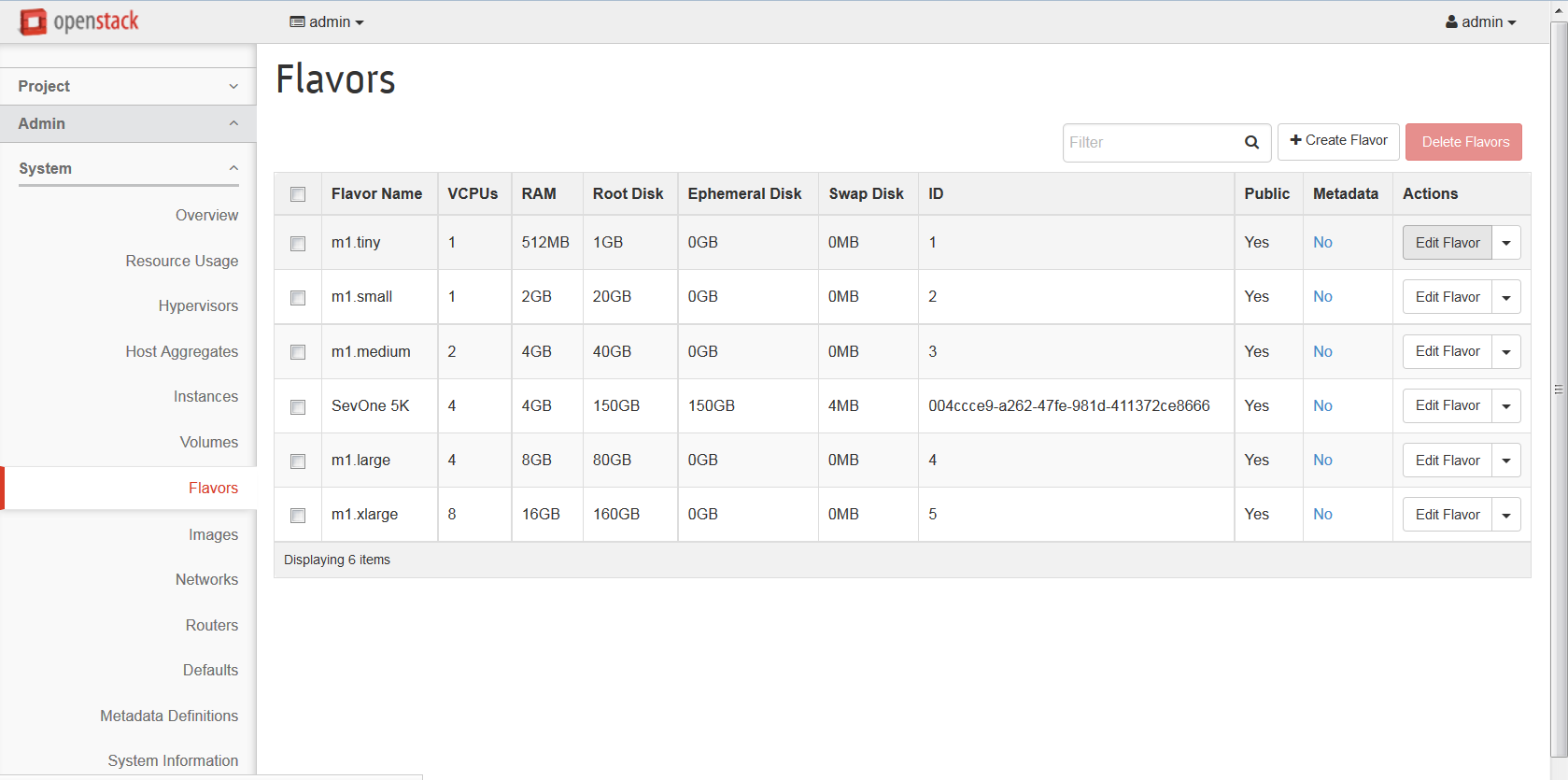
-
Click Create Flavor.
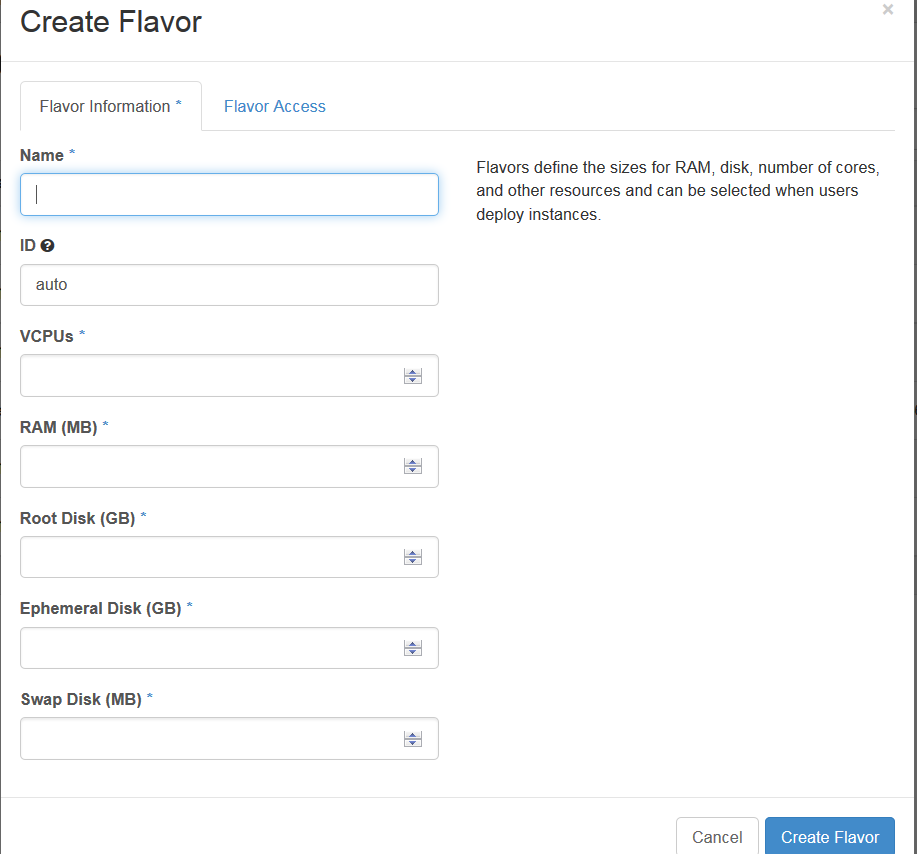
-
In the Name field, enter the name of the flavor.
-
In the ID field, enter the flavor identifier.
-
In the VCPUs field, enter the number of virtual CPUs. This is equal to the number of CPUs plus the number of cores listed in the requirements.
-
In the RAM field, enter the amount of RAM.
-
In the Root Disk field, enter the amount of space to allocate on the root disk.
-
In the Ephemeral Disk field, enter the amount of space to allocate on the ephemeral disk.
-
In the Swap Disk field, enter the amount of space to allocate on the swap disk.
-
Click Create Flavor to return to the Flavors page with the new flavor displayed in the list.
Perform the following steps to launch the instance for the virtual appliance.
-
In the left menu, select Compute then select Instances to display the Instances page that displays the status of your instances.

-
Click Launch Instance to display the Launch Instance page, Details tab, Advanced Options that enable you to define the details to launch an instance.

-
Click the Availability Zone drop-down and select an availability zone.
-
In the Instance Name field, enter the instance name.
-
Click the Flavor drop-down and select the flavor you created in the previous section.
-
In the Instance Count field, enter the instance count.
-
Click the Instance Boot Source drop-down and select Boot From Image (Creates New Volume).
-
Click the Image Name drop-down and select the image name.
-
In the Device Size field, enter the size of the device.
-
Click Launch to display the Launch Instance page Networking tab.
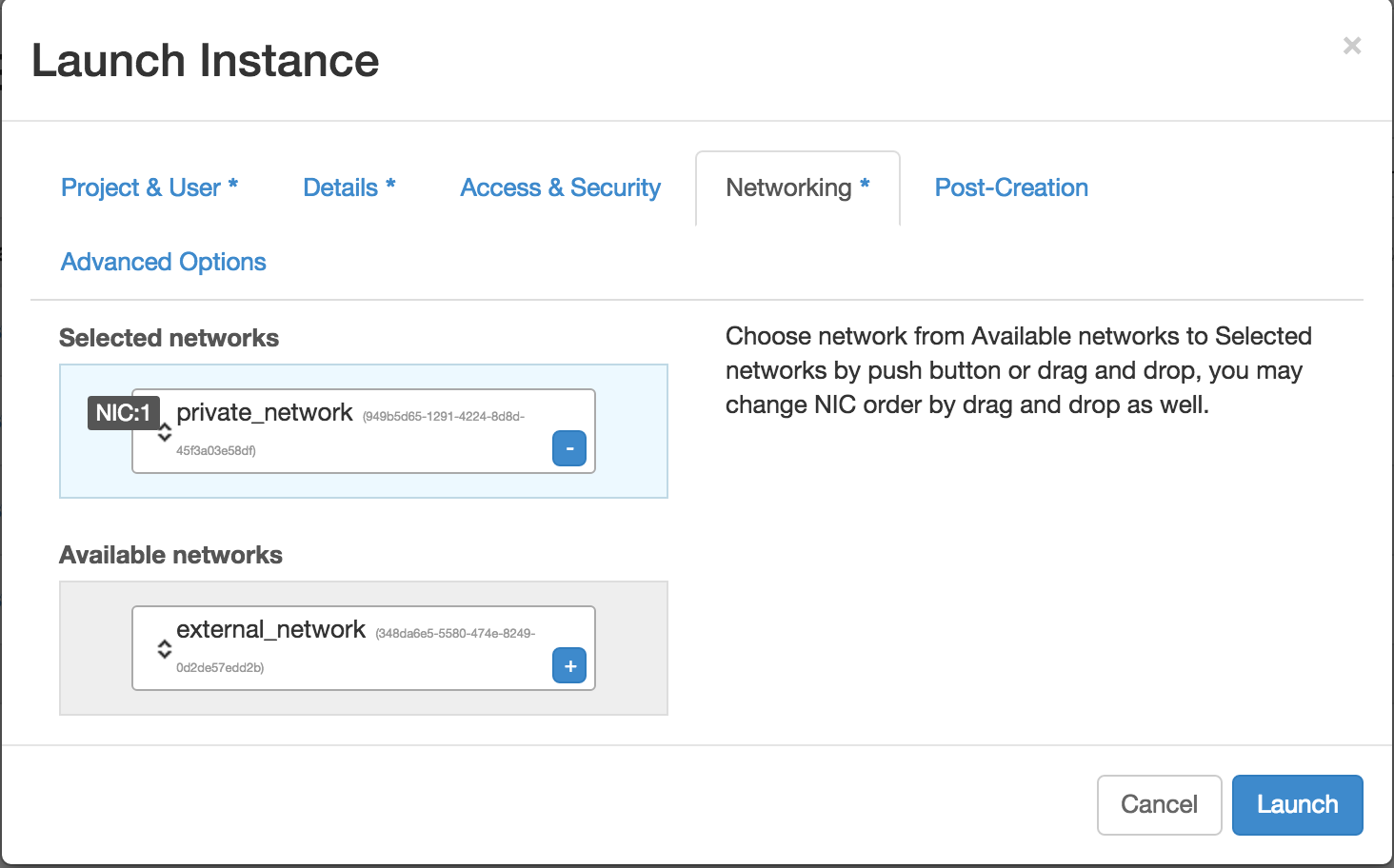
-
In the Available Networks section, click the + next to Private Network to move the Private Network to the Selected Networks field.
-
Click Launch to return to the Instances page and to add the new instance to the Instances list.
The Instances list now displays your instance.
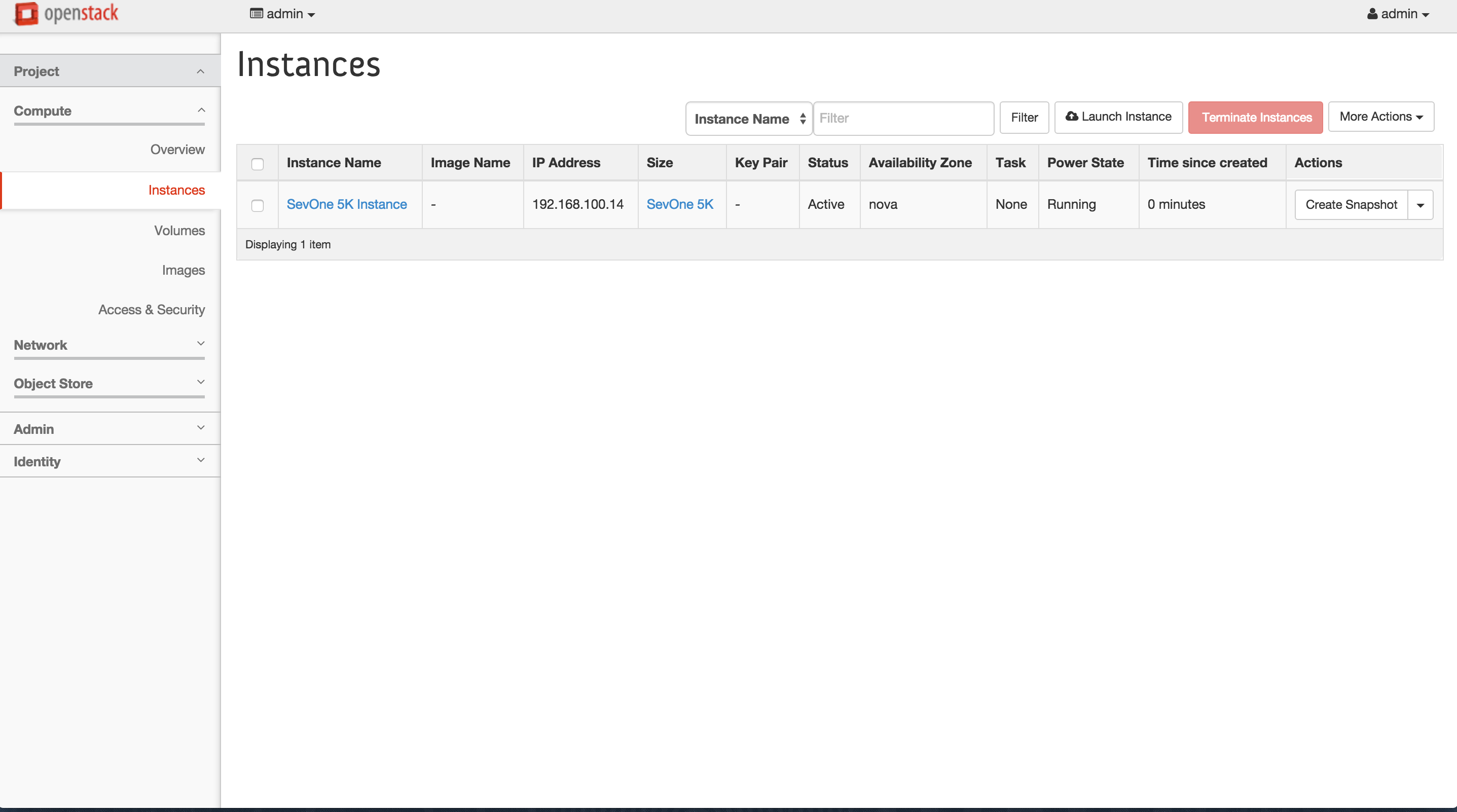
Perform the following steps to associate a floating IP address to the instance.
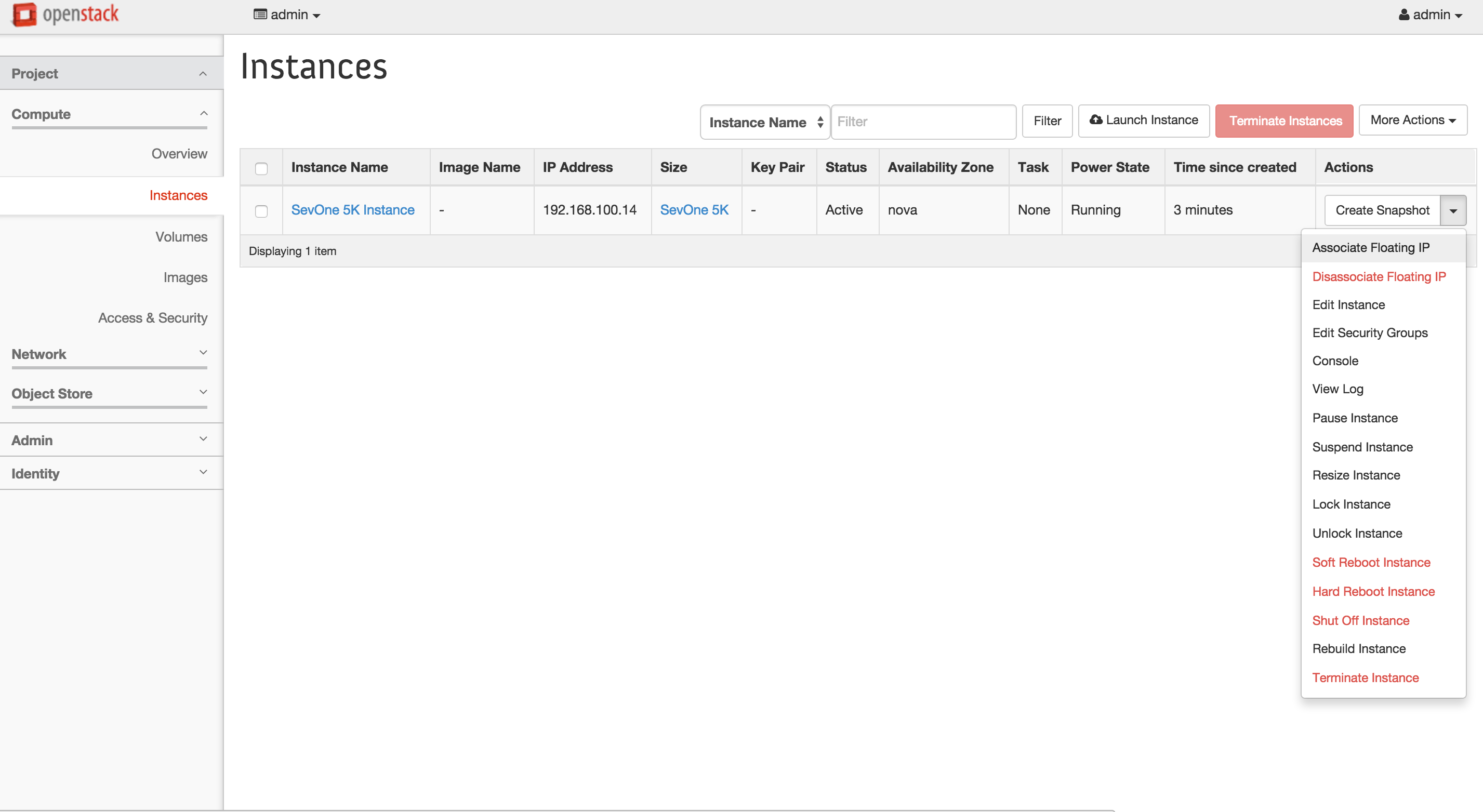
-
Click the Create Snapshot drop-down and select Associate Floating IP to display the Allocate Floating IP page.

-
Click the IP Address drop-down and select an IP address or click + next to the IP Address field to display the the Allocate Floating IP pop-up.
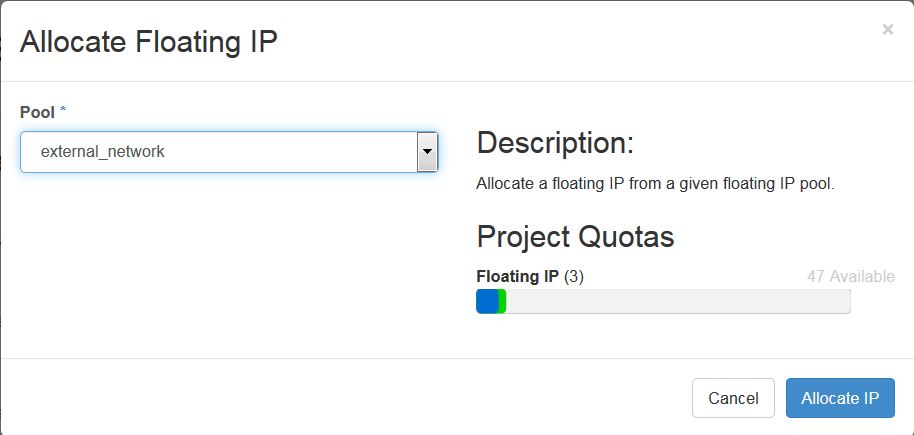
-
Click the Port to be Associated drop-down and select the instance for the virtual appliance.
-
Click Associate.
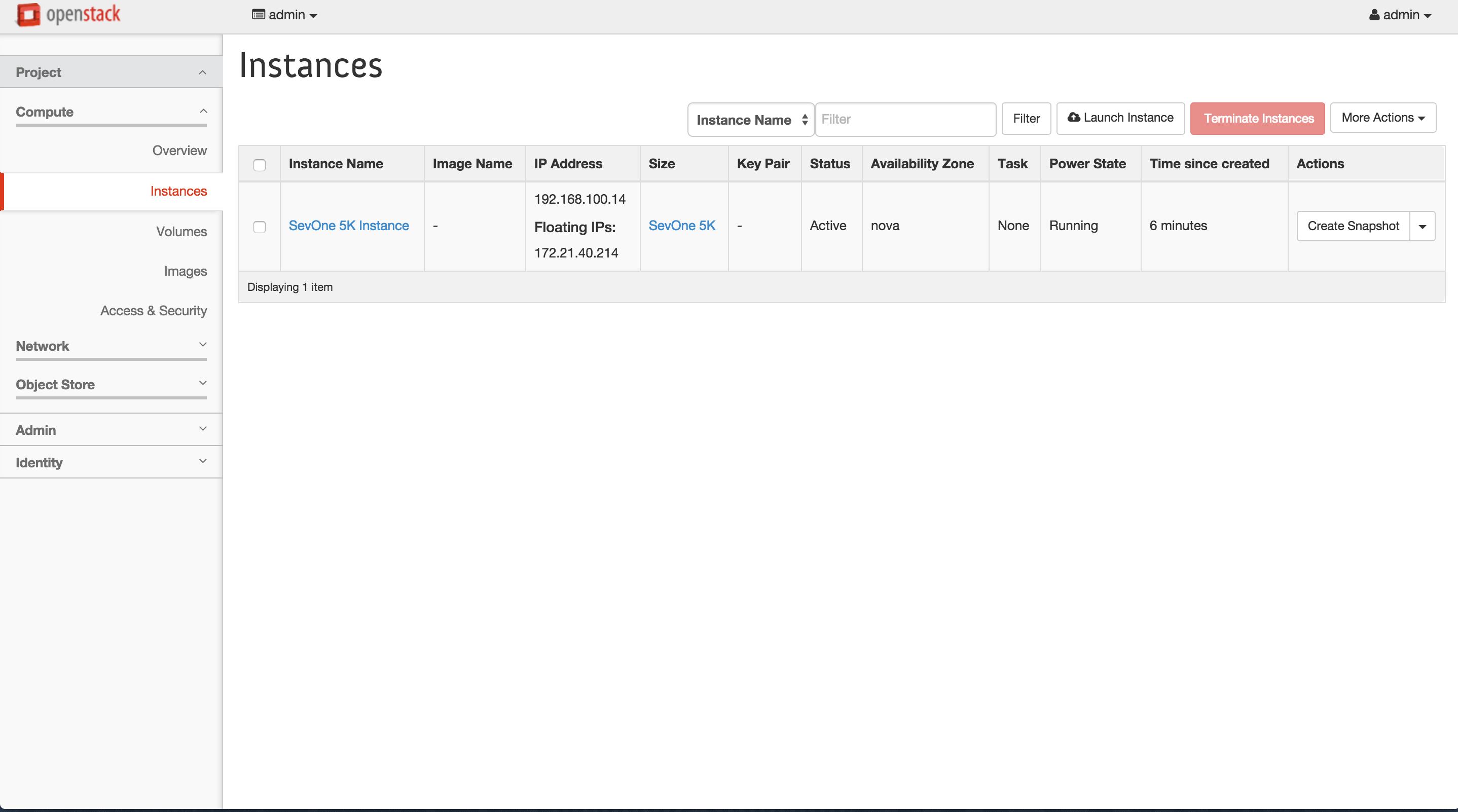
Enter the following command to boot the SevOne KVM implemented appliance.
$ qemu SevOne.qcow -boot c -net nic -net user -m 196 -localtimeOpenstack Command Line Implementation
If you do not have the Openstack GUI or you prefer to install the virtual appliance via an Openstack command prompt, you can enter the following commands via the command line prompt. The following is example is specific to a vPAS 20K and you must adjust the commands for other virtual appliance sizes etc.
$ openstack server create --image vPAS5K_CentOS_v5.7.2.0-kvm.qcow2 --flavor vPAS5K --security-group default --nic net-id=421d3d2d-4b29-4a43-89fa-4717f506fcb3 vPAS5K_CentOS_v5.7.2.0-kvm-qcow2-testKVM Drive Configuration for vPAS 100K
It is assumed that the SAN volume space has been created (blank) and attached to the KVM image in Openstack (or other management system). Additionally, it is assumed that the volume is attached as /dev/vdb. If the attachment differs from this, please use the correct path for your environment.
Perform the following steps.
$ mkfs.xfs /dev/vdb
$ mkdir -p /mnt/data_volume
Using a text editor of your choice, manually add the following entry to fstab to avoid formatting issues.
$ sed -i '$ a /dev/vdb /mnt/data_volume xfs defaults 1 2' /etc/fstab$ mount -a
The following is a precautionary step.
$ supervisorctl stop mysqld mysqld2 SevOne-netflowd SevOne-polld$ mv /data /mnt/data_volume$ mv /data2 /mnt/data_volume-
Using the text editor of your choice, edit /etc/fstab file and remove the line that contains /data and save the file.
$vi/etc/fstab -
Remove the line from /etc/fstab that contains /data.
-
Save /etc/fstab file.
-
Unmount /data.
$umount-l/data
-
Remove /data.
$rm-rf/data
$ ln -s /mnt/data_volume/data /data $ ln -s /mnt/data_volume/data2 /data2 $ ln -s /mnt/data_volume/data/index /index$ chown -R mysql:mysql /data /data2 /mnt/data_volume
The following is a precautionary step.
$ supervisorctl start mysqld mysqld2 SevOne-netflowd SevOne-polld$ for directory in system index data; do SevOne-ballast fill-all $directory; doneDeploy a Virtual Appliance Using a VHD on Azure
For steps to deploy a virtual appliance using a .vhd file on Microsoft Azure, see Microsoft's documentation at https://docs.microsoft.com/en-us/azure/virtual-machines/linux/create-upload-centos.
Network Configuration Via the Config Shell for VMware, KVM, and Azure Implementations
The config shell appears after you open the console on the SevOne NMS/SevOne PLA computer in the VMware implementation steps. Use the configuration menu to enter your company's network settings. For a KVM implementation, many of the config shell settings have already been entered. To access the config shell from a command prompt, enter the following command.
$ configshellFrom this point forward in the document, the SevOne NMS/SevOne PLA computer is referred to as the SevOne appliance. You need the following information:
-
System Name (Host Name)
-
Host IP address and sub-netmask
-
Broadcast address
-
Default Gateway IP address
-
DNS primary & secondary IP address
-
NTP (Time Server) IP address
-
SNMP Settings
-
Domain Name
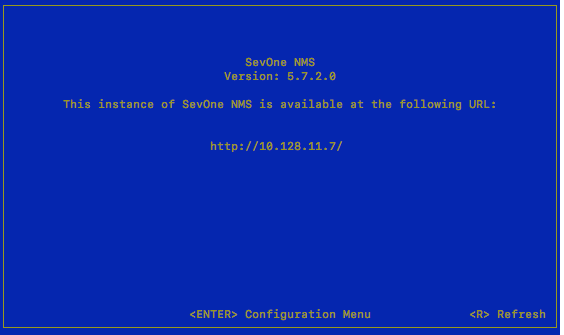
On the first page, press Enter to display the logon page that controls access to the Configuration Menu.

-
Enter the default password, supportuser .
When you log in here for the first time, you are logging as the user support. Steps for changing the default password for the support user are in the OS-level User Names and Passwords section. It is important that you change the default password.
Failure to change the default password presents a significant security risk.
-
Press Enter to display the system configuration menu.
Press the down arrow to select System Name in the left menu and press Enter to display the System Name fields on the right.
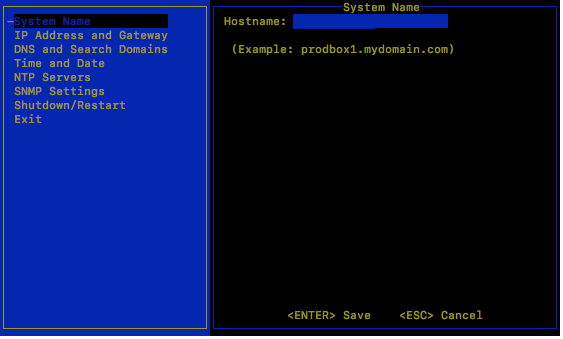
-
In the Hostname field, enter the hostname for the SevOne appliance.
-
Press Enter to save the System Name settings and return the focus to the menu on the left.
Press the down arrow to select IP Address and Gateway and press Enter to display the IP address and gateway fields on the right.
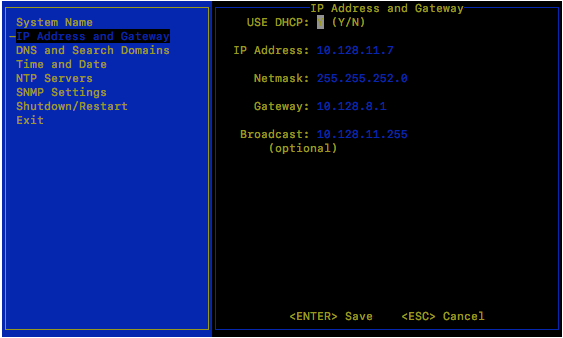
If your network uses DHCP type Y to disable the following fields and skip the IP Address and Gateway steps. If your network does not use DHCP, type N and complete the following fields.
-
In the IP Address field, enter IP address of the SevOne appliance and press Tab.
-
In the Netmask field, enter the netmask of the SevOne appliance and press Tab.
-
In the Gateway field, enter the IP address of the SevOne appliance and press Tab.
-
In the Broadcast field, enter the SevOne appliance broadcast IP address.
-
Press Enter to save the IP Address and Gateway settings and return the focus to the menu on the left.
Press the down arrow to select DNS and Search Domains and press Enter to display the DNS and Search Domains fields on the right.
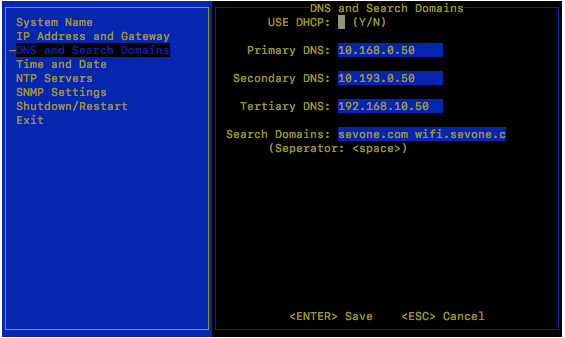
-
In the Primary DNS field, enter the IP address of the DNS server for the SevOne appliance to use first and press Tab.
-
In the Secondary DNS field, enter the IP address for the SevOne appliance to use second, if applicable and press Tab.
-
In the Tertiary DNS field, enter the IP address of the DNS server for the SevOne appliance to use third, if applicable and press Tab.
-
In the Search Domains field, enter the domain names or IP addresses for the search domains for the SevOne appliance to use (separated by a space).
-
Press Enter to save your DNS and Search Domains settings and return the focus to the menu on the left.
Press the down arrow to select Time and Date and press Enter to display the Time and Date fields on the right.
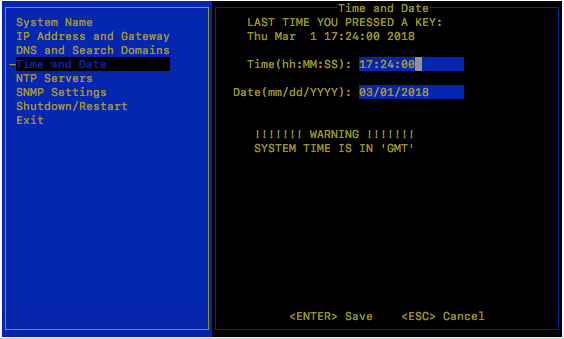
-
Confirm that the time and date are correct for Greenwich Mean Time (GMT) (a.k.a. Coordinated Universal Time (UTC)). This is the SevOne NMS/PLA system time. You define time and date settings for users, devices, and reports via the SevOne NMS/PLA GUI in a later step.
-
If needed, enter the time and date using the appropriate format in the fields provided.
-
Press Enter to save the Time and Date settings and to return the focus to the menu on the left.
Press the down arrow to select NTP Servers and press Enter to display the NTP Servers fields on the right.
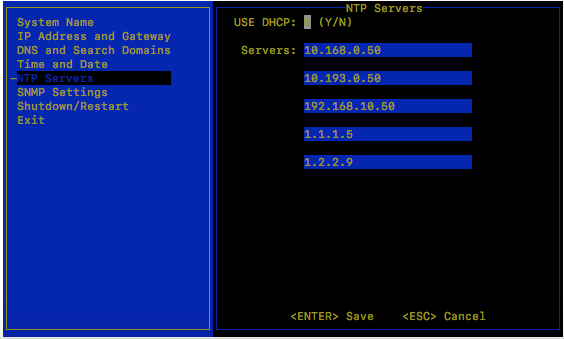
-
In the Servers field, enter the DNS name or IP address of the time server for the SevOne appliance to use to maintain time settings.
-
Press Enter to save the NTP Servers settings and to return the focus to the menu on the left.
Press the down arrow to select SNMP Settings and press Enter to display the SNMP Settings fields on the right.
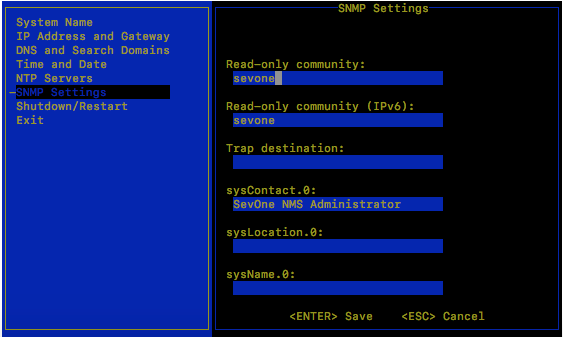
-
In the Read Only Community field, enter the SNMP read community string for other devices to use to poll SNMP data on the SevOne appliance when communicating via IPv4 and press Tab.
-
In the Read Only Community (IPv6) field, enter the SNMP read community string for other devices to use to poll SNMP data on the SevOne appliance when communicating via IPv6 and press Tab.
-
In the Trap Destination field, enter the IP address or hostname of the destination where traps the SevOne appliance generates are to be sent and press Tab.
-
In the sysContact.0 field, enter the text you get when you SNMP walk the sysContact OID and press Tab.
-
In the sysLocation.0 field, enter the text you get when you SNMP walk the sysLocation OID and press Tab.
-
In the sysName.0 field, enter the text you get when you SNMP walk the sysName OID.
-
Press Enter to save the SNMP Servers settings and to return the focus to the menu on the left.
If you changed the System Name settings or the IP Address and Gateway settings, press the down arrow to select Shutdown and Restart and press Enter to display a Shutdown option and a Restart option on the right.
For all other configuration setting changes, you can press the down arrow to select Exit.

In the Shutdown/Restart section select an option and press Enter to shut down or reboot the SevOne appliance.
If you highlight Exit, when you press Enter the initial Configuration Menu Welcome page appears.
For details on advanced Network Configurations such as configuring Virtual IP (CentOS) or peer communication over NAT, please refer to SevOne NMS Advanced Network Configuration Guide for details.
Install vPAS/vDNC License File
Your vPAS/vDNC license file is attached to the email.
-
Save the <license>.dat file to a location that is accessible by the SevOne appliance.
-
Enter the URL for the SevOne appliance into your web browser to display the license agreement.
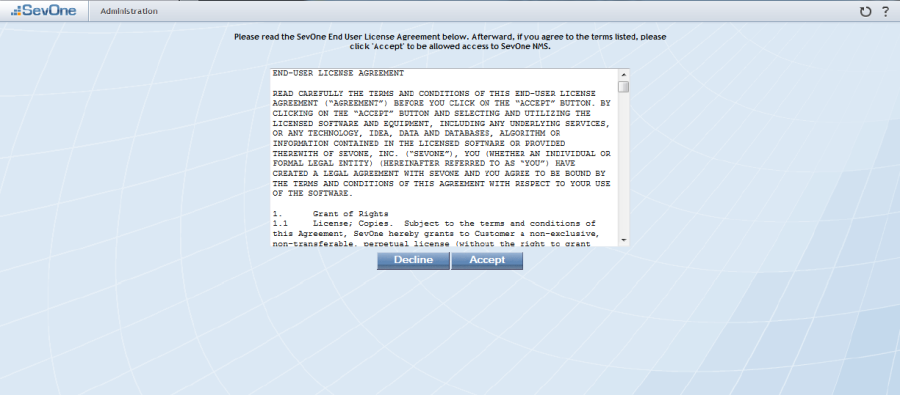
-
Click Accept to display the License Upload page.
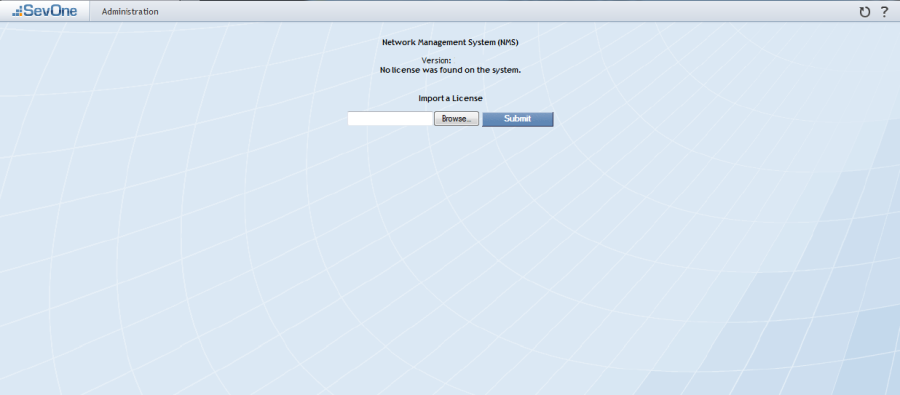
-
Click Browse.
-
Navigate your file hierarchy to the license.dat file, select the <license>.dat file, and click Open.
-
Click Submit to import the license.
-
On the Finish Importing Certificate message, click OK.
-
Restart your browser.
SevOne PLA Email Server Setup
Perform the following steps to define the email server for the SevOne PLA to use to send report and alert emails. For SevOne NMS, skip this section.
-
From the command line, enter the following command to display the current email server settings.
$set-email-server -
Enter ^C to keep the current settings.
-
When prompted, enter the URL for the mail server.
-
When prompted, enter the username for the mail sender.
-
Enter the password for the sender to connect to the server (or leave blank for no password).
-
Enter the email address from where emails are to be sent.
Add a SevOne PLA to a SevOne NMS Cluster
Perform the following steps to include the SevOne PLA in a SevOne NMS cluster.
Generate Token
You can enter the following command on the SevOne PAS appliance to generate a token for the PLA appliance.
$ wget http://<PLA Appliance IP Address>/rapid/req.php --post-data-data='{"action": "request-superadmin-action-tokens", "user":"admin", "pass":"test" }' -qO-To avoid sending credentials over the wire, you can enter the following command on the PLA appliance. Substitute localhost for the IP address.
$ wget http://localhost/rapid/req.php --post-data='{"action": "request-superadmin-action-tokens", "user":"admin", "pass":"test" }' -qO-Sample Return:
{"tokens":{"function":"get-mass-volume-info","token":<token>}}
Store Authentication Token and PLA IP Address in the SevOne-act
Enter the following command on the SevOne PLA appliance.
$ SevOne-act pla init-set-pla --ip <PLA Appliance IP Address> --token <Token>
Note: Use only the token string itself without the double quotes
.
OS-level User Names and Passwords
You will need to change the default passwords for the admin, root, and support user accounts. This is important for security reasons.
Failure to change the default passwords presents a significant security risk. This publication includes default passwords and this document has probably been made available to the public.
Change Admin Password
The admin user is not used by any SevOne utilities. It exists for administrators/customers. This password should be changed on all peers. Perform the following steps to change the password for admin.
-
SSH into your SevOne NMS appliance and log in as admin.
-
At the Password prompt, enter adminuser.

-
You will be prompted and required to change the admin user password. Enter a new password when prompted.
-
Exit the session when you are done.
Change Root Password
You must change the root password for new appliances when you SSH into the system. You will be prompted for the default password and will be required to change the password. This must be completed before incorporating the new peer into a cluster. Security concerns prevent incorporation of peers that use the default password.
SevOne NMS uses the root account for everything. This password should be changed on all peers. Perform the following steps to change the password for root.
-
SSH into your SevOne NMS appliance and log in as root.
-
At the Password prompt, enter dRum&5853.

-
You will be prompted and required to change the root user password. Enter a new password when prompted.
-
Exit the session when you are done.
Change Support Password
The support user is used by configshell. Configshell does not store the password for this account anywhere. You will need the password you specify here when logging in to configshell. This password should be changed on all peers. Perform the following steps to change the password for support.
-
SSH into your SevOne NMS appliance and log in as support.
-
At the Password prompt, enter supportuser.

-
You will be prompted and required to change the support user password. Enter a new password when prompted.
-
Exit the session when you are done.
Enable Firewall for CentOS
Prior to enabling firewalld , please make sure that iptable services are not being used. SevOne does not recommend using firewall and IPTABLES services at the same time as this is not supported.
On appliances that are running CentOS, the firewall will be disabled. This applies to both appliances with new SevOne NMS installs and appliances that were previously running Gentoo, then moved to CentOS. Perform the following steps to enable the firewall.
-
SSH into the appliance as root.
-
Execute the following command to enable firewalld:
$/usr/bin/systemctlenablefirewalld -
Execute the following command to start firewalld:
$/usr/bin/systemctlstart firewalld -
Execute the following command to identify custom ports:
$netstat-tuplet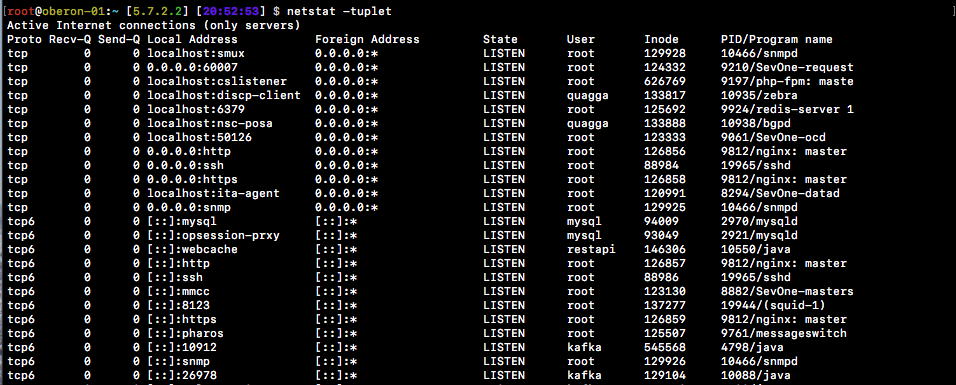
-
Execute the following command to add a custom port to the firewall. Replace <portNumber> with the number of the port you want to add. Replace <connectionType> with tcp or udp.
$ firewall-cmd --zone=public --add-port=<portNumber>/<connectionType> --permanent -
Execute the following command to reload the firewall and apply changes:
$ firewall-cmd --reload -
Exit the session when you are done.
Shut Down and Reboot SevOne NMS
SevOne NMS can run for extended periods of time. Occasionally it is necessary to shut down or reboot an appliance. SevOne NMS stores data in cache and writes to the disk on a regular basis.
Use the configshell to shut down the software or the following shell commands back up the memory ring tables to the database on the disk to ensure that you do not lose data.
$ SevOne-shutdown shutdown
$ SevOne-shutdown reboot